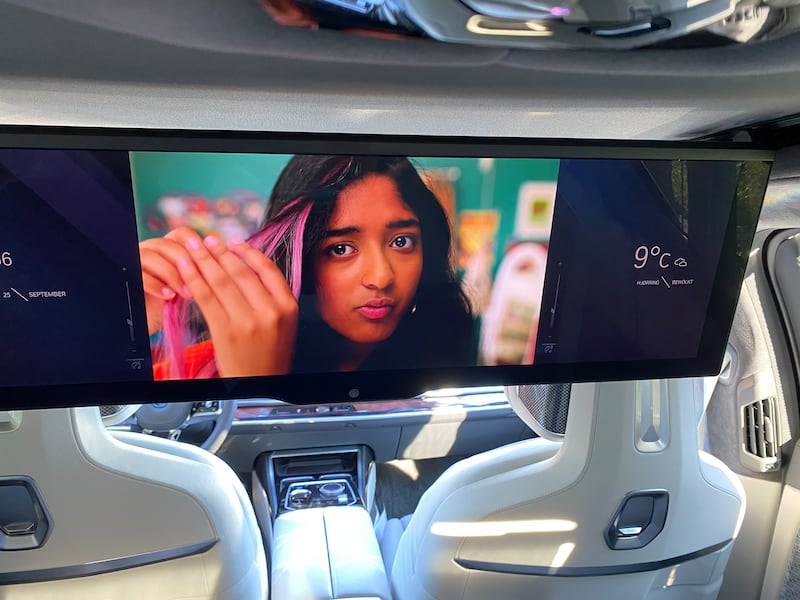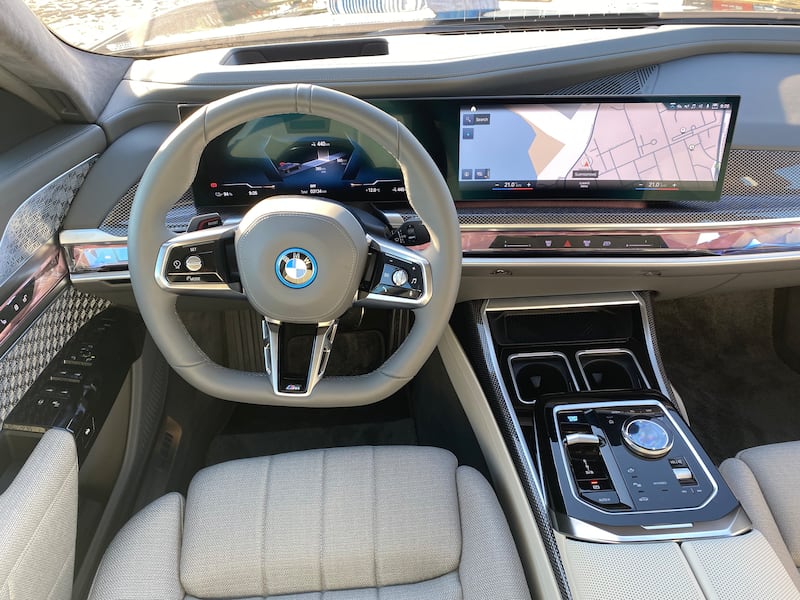When it comes to luxury saloons, where does the buyer sit? It may seem a trifling matter, but it decides a lot about the layout of a car.
Take the Mercedes-Benz EQS, its flagship all-electric saloon, aiming to lure some of its traditional S-Class owners into the new age of motoring. Here the impressive spread of touchscreen controls stretch across the dash. It’s all very futuristic – and up front.
Turn to the new BMW i7, it’s all-electric rival and the big infotainment talking point is a massive 31.2-inch touchscreen theatre display that drops from the roof to entertain the rear seat occupants.
Touchscreen controls – similar to smartphone screens – are also built into the rear door armrests. As a final touch, the i7 driver can remotely open and close any or all of the car’s doors from the front seat.
READ MORE
Screens, of course, do not make the car, but the contrasting formats suggest that Mercedes reckons its EQS owners will be behind the wheel, while BMW believes its i7 buyers will be sprawling out in the back seat.
Want further proof? When the big theatre screen drops down from the BMW’s roof, it blocks out the driver’s rear-view mirror, delivering the sort of visibility usually encountered by van drivers.

Clearly BMW has its focus on lucrative Asian markets, where the well-heeled buyers usually employ drivers. Other telltale signs of this Asian bias include the decision to adorn the i7 with a front grille the size of a household storage heater and an assortment of bling features that would provide a suitable backdrop to any rap video.
Back at Mercedes, things are a little more subtle, perhaps a little too subtle even, when it comes to the EQS’s exterior styling.
Yet the biggest difference between the S-Class and EQS is behind the wheel: while the EQS promises an impressive range on a single charge, the car simply isn’t as good to drive as its supremely excellent sibling, the S-Class.
Coincidentally, arch-rivals BMW – perhaps by happenchance – has delivered a massive luxury liner that’s better to drive, not only than the regular 7 Series, but also the EQS. For all its focus on the back seats, the person behind the wheel of the i7 is the one who will have the biggest smile on their face.
The main hurdle you face when encountering the i7 is to focus on the car and not get distracted with the array of electronic gizmos.
It’s a big challenge. A BMW spokesman demonstrating the various new functions reckoned the handover time for new owners would be about 90 minutes. Honestly, that seems enormously ambitious, particularly if the buyer hasn’t experienced in the last five years the sort of tech that’s loaded into a new car these days.

Let’s leave the back seat cinema for now and get behind the wheel. This is a big car, delivering all-wheel drive power via two electric motors putting out a combined 544hp, with a bias towards the rear wheels. It claims a range of up to 625km from its battery pack of 101.7kWh of usable power, which is efficient, though less than the 761km claimed by the Mercedes EQS 450+.
This 2.7-tonne beast can reach 100km from a standing start in 4.7 seconds. But the big news is the way it stops. Unlike the Mercedes, where regenerative braking is evident through the initial touches of the pedal, here you get full anchoring when you hit the brakes.
That mix of near-instantaneous acceleration with reassuringly grippy brakes is what we expected from the Merc but it’s best delivered here in the BMW. And it is what’s needed for a car of this size with that pace.
It offers the reassurance to encourage you through the corners and here the i7 defies its size, with impressive agility. It’s clearly no sports car, but it delivers better poise and smoother performance than many smaller rivals.
As you can expect the ride is cosseted, but BMW manage to transmit enough information from the road through the steering feel to keep the driver informed and connected.
Prices are steep – starting at €133,085 – but you can set that against €92,822 for the iX crossover and circa €100,000 for any all-electric premium sports coupe these days. Maybe it’s a sign of inflation biting, but the i7 price tag no longer seems astronomically outlandish.
The front seat versus back seat strategy is interesting and we look forward to watching how this plays out in the various markets. If nothing else, it could form the basis for some undergrad’s culture studies dissertation.
There are touches to the i7′s interior that are gaudy and naff – like the clear plastic bar that ran across the dash of our test car, designed to look like crystal. It gave the car all the class of a Russian nightclub.
Normally at the luxury table, Mercedes holds court, and BMW would be fighting for the crumbs with Audi, Lexus and Jaguar. Not with this car.
The i7 is BMW’s best chance in a generation to put up a proper challenge to Mercedes for the luxury saloon crown.















